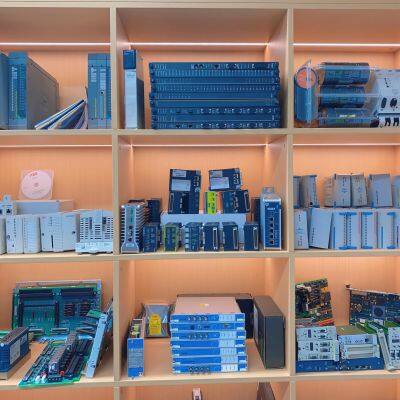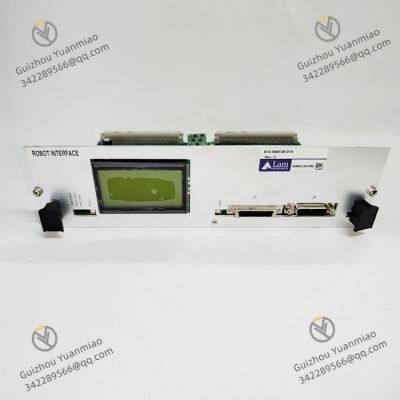Product Description
The Lam Research 810-068158-014 is a printed circuit board assembly (PCBA) specifically designed for the core control modules of semiconductor manufacturing equipment. It is primarily compatible with Lam Research’s semiconductor process equipment such as etching (Etch) and deposition (Deposition) systems, undertaking critical functions including signal processing, power driving, and logic control for the equipment’s key subsystems. As a "hardware neural node" of semiconductor equipment, its design strictly adheres to the semiconductor industry’s requirements for high reliability, anti-interference capability, and precise signal transmission, making it a pivotal component for ensuring equipment process stability and production yield.
I. Basic Information and Core Positioning1. Interpretation of Model and Product Identification
Lam Research’s PCBA model follows the logic of "equipment compatibility + function coding + version iteration". The specific meaning of the 810-068158-014 identification is as follows:
810: Equipment platform prefix, corresponding to a specific series of Lam Research’s process equipment (e.g., a generation of etching machines or thin-film deposition equipment), indicating the core range of equipment models that this PCBA is compatible with.
068158: Function code, corresponding to the PCBA’s specific functional module (e.g., "RF power control sub-board", "vacuum system signal conditioning board", or "wafer transfer logic control board"). The exact function must be confirmed in conjunction with the equipment subsystem; Lam Research has not fully disclosed a universal coding dictionary, so reference to the equipment manual is required.
014: Version number (Revision 14), representing the hardware iteration version of this PCBA. Subsequent versions (e.g., 015, 016) may optimize component selection, circuit layout, or compatibility, and are generally backward-compatible with previous-generation equipment.
2. Core Application Scenarios
This PCBA is an original equipment manufacturer (OEM) spare part for Lam Research’s semiconductor equipment, exclusively used for the maintenance, upgrading, and servicing of its own semiconductor process equipment. Specific applications include:
Etching equipment (e.g., plasma etching machines): May be responsible for RF (radio frequency) power regulation signal processing and plasma parameter monitoring signal amplification.
Deposition equipment (e.g., Chemical Vapor Deposition (CVD), Physical Vapor Deposition (PVD) systems): May manage reaction chamber pressure control logic and gas flow valve drive signal output.
Wafer transfer systems: May participate in signal processing for wafer robot arm position calibration and monitoring/feedback control of vacuum adsorption status.

II. Key Technical Parameters
Due to Lam Research’s "partial confidentiality" strategy for the technical parameters of core equipment components (to prevent the leakage of core process technology), the following parameters are summarized based on general standards for semiconductor equipment PCBs and publicly available industry information. For exact specifications, refer to the original equipment manufacturer’s technical manual.
III. Core Functions and Technical Characteristics1. Signal Processing and Conditioning
As a "signal transfer station" for equipment subsystems, it undertakes the collection, amplification, and filtering of front-end sensor signals, as well as the conversion and output of back-end control commands:
Analog signal processing: Amplifies (with adjustable gain) and filters (to remove high-frequency noise) weak analog signals (e.g., mV-level voltages) output by pressure sensors, temperature sensors, and flow sensors, converting them into standard signals (0-10V/4-20mA) recognizable by the equipment’s main controller to ensure the accuracy of process parameter monitoring.
Digital signal interaction: Communicates with the equipment’s main CPU via serial communication interfaces such as SPI, I2C, and UART, transmitting control commands (e.g., "adjust valve opening", "start sensor calibration") and status feedback data (e.g., "current module temperature", "signal link integrity"). The communication delay is ≤ 1ms, meeting real-time control requirements.
2. Power Driving and Safety Protection
If this PCBA is involved in power control subsystems (e.g., driving equipment valves, pumps), it integrates power driving and fault protection functions:
Power output: Converts low-voltage control signals into high-voltage/high-current drive signals (e.g., 24V/5A) via power MOSFETs or IGBT driver chips to drive actuator operations.
Safety protection: Built-in overcurrent protection (OCP), overvoltage protection (OVP), and overtemperature protection (OTP) circuits. When excessive output current, abnormal power supply voltage, or excessive PCB temperature (e.g., >90℃) is detected, it automatically cuts off power output and sends a fault signal to the upper-level controller to prevent component burnout or equipment damage.
3. High Reliability and Stability Design
To meet the "24/7 continuous operation" requirement of semiconductor equipment, this PCBA features enhanced reliability in its design:
Component selection: All components are industrial-grade or military-grade, with a temperature range of -40~125℃ and a component lifespan of ≥ 100,000 hours (MTBF, Mean Time Between Failures).
Redundancy design: Key signal links (e.g., sensor inputs, power outputs) adopt dual-channel redundancy. If one channel fails, it automatically switches to the backup channel to avoid equipment shutdown due to a single point of failure.
Heat dissipation optimization: The PCB uses high-thermal-conductivity copper-clad material, and heat dissipation vias are designed under key power components. Combined with the internal heat dissipation air duct of the equipment, the operating temperature of components is controlled to ≤ 70℃ (typical value).

IV. Compatible Equipment and Replacement & Maintenance1. Compatible Lam Research Equipment Series
This PCBA is a dedicated spare part for specific Lam Research equipment platforms, with primary compatibility including but not limited to:
Etching equipment: Kiyo® series plasma etching machines, Syndion® series metal etching machines;
Deposition equipment: Endura® series Physical Vapor Deposition (PVD) equipment, Victory® series Chemical Vapor Deposition (CVD) equipment;
Others: Core control subsystems of wafer cleaning equipment and thin-film measurement equipment (specific compatibility must be confirmed via Lam Research’s equipment model and spare parts list).
2. Key Points for Replacement and Maintenance
Replacement prerequisites: Must be operated by Lam Research-certified engineers. Before replacement, the power supply to the corresponding subsystem of the equipment must be cut off to avoid component damage caused by hot-swapping.
Calibration requirements: After replacement, the signal accuracy and power output of the PCBA must be calibrated using Lam Research’s dedicated calibration software (e.g., Lam Equipment Calibration Tool) to ensure compatibility with the equipment’s main system. The calibration cycle is typically once a year (or every 1,000 hours of operation).
Spare part management: As a critical spare part for semiconductor equipment, it must be stored in a clean, dry environment (temperature 20-25℃, humidity 30%-60%) to avoid electrostatic damage (it should be placed in an anti-static packaging bag during storage).


ABB RMU610 2VAA008425R1 Repeater Mounting Unit
ABB CHBX01L 2VAA008574R1 Compact Bus Extender
ABB CHBX01R 2VAA008575R1 Compact Bus Extender
ABB UFC921A 3BHE024856P106 Communication Module
ABB PP886 3BSE092980R1 Operation Panel
ABB SUE3000 1VCF750090R0804 Maintenance Exchange Unit
ABB SUE3000 1VCR007346 G0032 REF542plus HMI Unit
ABB GFD563A101 Interface Module
ABB 3BHE046836R0101 Interface Module
ABB UNS0881b-PV2 PCB Circuit Board
ABB 3BHE050077R0102 PCB Circuit Board
ABB 500PB101 1MRB200064/C Binary Output Module
 yezi
Hi there! Welcome to my shop. Let me know if you have any questions.
yezi
Hi there! Welcome to my shop. Let me know if you have any questions.






